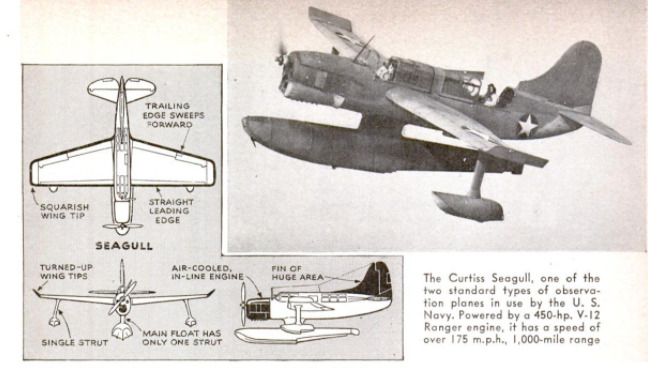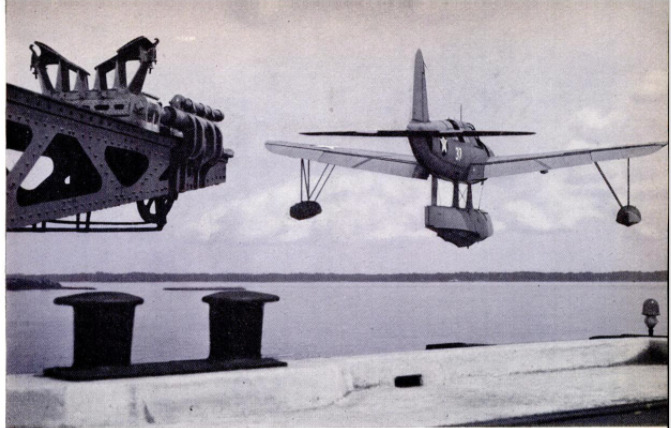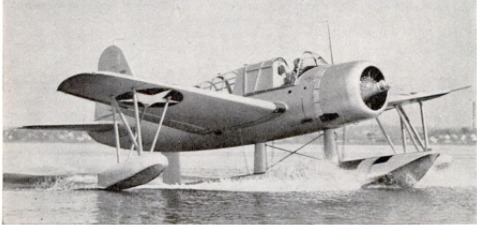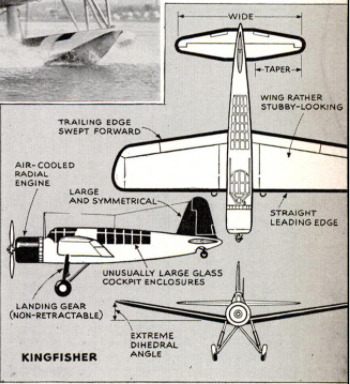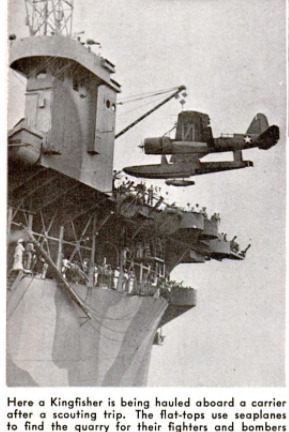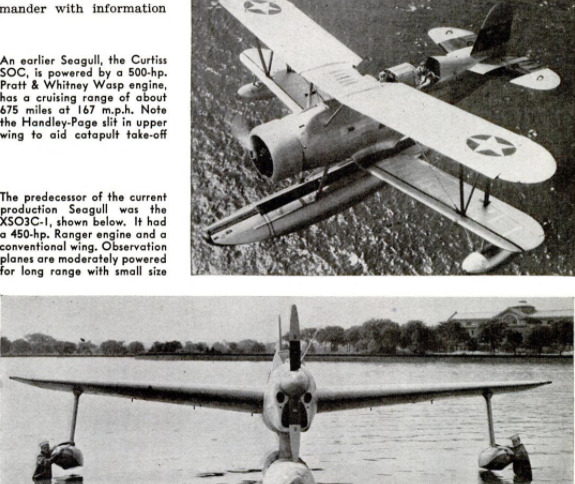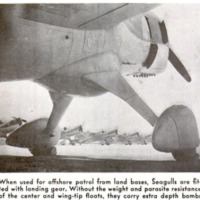-
Title (Dublin Core)
-
Slingshot planes for reconnaissance
-
Article Title and/or Image Caption (Dublin Core)
-
Title: Slingshot planes
-
Subtitle: Guide our fighting ships to new victories
-
extracted text (Extract Text)
-
THE first job that aircraft had in any navy
was that of looking around for the fleet.
As soon as Glenn Curtiss landed his tiny
seaplane alongside the U.S.S. Pennsylvania
in February 1911, even the most shellbacked
of naval sea dogs had to admit that the air-
plane was capable of outscouting any other
observation device. Three years later, in
the naval operations at Vera Cruz, when
Lieutenants Bellinger and Towers spotted
hit corrections for the warships Mississippi
and Birmingham, aircraft's place as the eyes
of the Navy seemed estab-
lished.
It was not, however, until
1919, when the lessons of
World War I began to be di-
gested and a workable cata-
pult was perfected, that float
observation seaplanes became
standard equipment on all
cruisers and battleships in
the U.S. Navy. A special
seaplane, the Vought UO-1,
was designed for the work
and the airplane became as
much a part of the ship-of-
the-line as the fire-control
tower or the gun turret.
Observation units do two
general kinds of work and
their ships are classified by
the letters VOS and VSO.
“V" is the Navy's general
classification for heavier-
than-air. “0” stands for ob-
servation, “S” for scouting.
Thus a ship catalogued VOS
will be equipped primarily for observa-
tion, with scouting as a secondary duty.
Its primary function will be to extend
the field and accuracy of the main ord-
nance battery of the ship to which it is
attached. In effect, it becomes an aux-
iliary fire-control station, placed higher
than the ship and, when necessary,
closer to the target. From data re-
layed from the plane by radio, the ship's
guns can fire at a target they could
not sight with shipboard fire-control
equipment.
The job of a VSO plane is scouting—
scouring the ocean for signs of the ene-
my and reporting his activity. In the old
days, destroyers and cruisers did this
job. Working on the surface, a fast vessel
can scout an area 10 miles wide and 250
miles long in 10 hours if the visibility is
five miles. The same ship, with four air-
planes with a cruising speed of 120 miles an
hour spaced ten miles apart, can cover an
area 50 miles wide and 780 long in the same
time.
This basic mission is frequently aug-
mented by anti-submarine duty or bom-
bardment, so the observation plane is
equipped with racks for depth charges and
bombs.
Of all the types of aircraft used by the
fleet, the observation plane is, for its size,
the most difficult to design. It is required
to do more kinds of work and has the great-
est number of engineering limitations. To
begin with, its size is limited. It cannot
have a wing span larger than the diameter
of space allowed for catapult operation. Its
wings must fold; its weight must not exceed
the operating capacity of the catapult, Fur-
ther, It must have critical speed low
enough to allow it to attain flying speed in
the length of the catapult run
To bo useful 4a i Acouting medium, tho
plane must have considerable range. With
the size limitations, this can be achieved by
using _medium-powered, economical en
Kine. Actually, scout-observation type 18
leas powerful than an advanced trainer. It
must havo enough capacity for necomsary
operational equipment radio, cameras, and
some destructive and some defensive armi-
ment. Being, for the most part, equipped
an seaplane, ihey carry their water gear
consisting of a main center float and two
wing-tip auxiliaries which add welght and
paraite resistance.
Add to the engineering complications the
fact that the observation type 1a also re-
quired to be capable of landing in wells it
necessary without regard to wind direction.
The ship also must be made virtually cor:
rosionproof, which robs it of more payload
or performance. With ail this, the scout
must still retain enough performance to
allow for defense against other aircraft.
The current scout types are a fair approach
to all these demands.
Frequently these characteritics inthe
plane, combined with combat judgment on
the part of the crow, manage to be n fair
substitute for gunpower, as in the case of
an observation ship operating in the first
phase of the African campaign. It was
Spotting for a cruiser when a £roup of three
land-based fighters dived down on It. Feign-
ing panic, the pilot ducked in and out of
group of broken clouds, dropping out of
them directly over his ship. He pulled out
at an altitude that gave the cruiser's anti-
arcraft gunners a perfect target, After
the fighters were properly polished off, the
scout went about its business again, spot-
ting hits.
It should also be remembered that we
owe one of our most brilliant naval vie
tories in the Solomons to a VSO ship. Fly-
ing several hundred miles into enemy
waters, the pilot spotted a Jap task force
heading for the Solomons. Despite harass-
ing fire, he climbed out of range and ra-
dioed the information to his base ship.
No part of the fleet's air strength is more
a part of the real, saltwater Navy than the
observation units. Fighters, bombers, and
torpedo planes are, in a sense, merely pas-
sengers on a carrier. Observation craft are
more a part of the surface vessel, and their
pilots must be qualified as deck officers and
gunnery experts. They must know fire-
control and ordnance limitations, so that
they can observe and relay fire-correction
information. They must know naval tactics,
so that they can understand and interpret
the shifting pattern of
naval operations and pro-
vide the surface com-
mander with information
needed for successful deep-water operations.
There are two new types of observation
craft in ordinary use, although several older
types are still in active service. One is the
Vought-Sikorsky Kingfisher, the type that
effected the Rickenbacker rescue. It has a
wing span of 36 feet; its seaplane version is
33 feet, 10 inches long. Powered by a 450-
hp. Pratt & Whitney Wasp engine, it has a
top speed of over 175 m.p.h. The range is
about 1,000 miles. The other, the Curtiss
Seagull, has a wing span of 38 feet and is
35 feet, eight inches long. Powered by a
450-hp. V-12 air-cooled Ranger engine, it
has a top speed over 175 mph and a
1,000-mile range.
‘When you read in your newspaper that our
fighting ships have met the enemy anywhere
on the high seas, you may be sure that the
slingshot planes were in on the scrap, spot-
ting the foe and bringing in vital informa-
tion to make the victory sure,
HELICOPTERS are being made for the Army
by the Vought-Sikorsky company as the re-
sult of successful tests on an experimental
model. Although this type of craft is lim-
ited in speed and lifting power, it has the
great advantages of being able to rise and
descend vertically, fly either forward or
backward, hover motionless over a given
spot, and operate from land, water, snow,
or thin ice. Because of its ability to “hang”
in the air, it is effective for observation.
BUILT-IN TIRE CHAINS are increasing the
traction of the Goodyear Diamond nonskid |
tires used on Army planes. Designed for |
high-speed landings and take-offs on small |
fields covered with ice or snow, the new tire |
has embedded in its tread thousands of spi-
ral metal rings that supplement the dia-
mond tread. The rings may be seen in the |
carcass of the tire, at the left. Above, the |
finished tire is taken from its mold. |
A BIRD CANNON oper-
ated by compressed air,
shooting dead 15-pound
turkeys, through the air
at 200 miles an hour, is
used to test birdproof
windshields for Army
planes. Shields combining
tempered glass and resil-
ient plastic have been
found to withstand the test.
-
Contributor (Dublin Core)
-
William S. Friedman (Article Writer)
-
Language (Dublin Core)
-
eng
-
Date Issued (Dublin Core)
-
1943-05
-
pages (Bibliographic Ontology)
-
60-65
-
Rights (Dublin Core)
-
Public Domain (Google Digitized)
-
Archived by (Dublin Core)
-
Matteo Ridolfi
-
Marco Bortolami (editor)
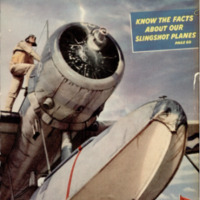 Popular Science Monthly, v. 142, n. 5, 1943
Popular Science Monthly, v. 142, n. 5, 1943

